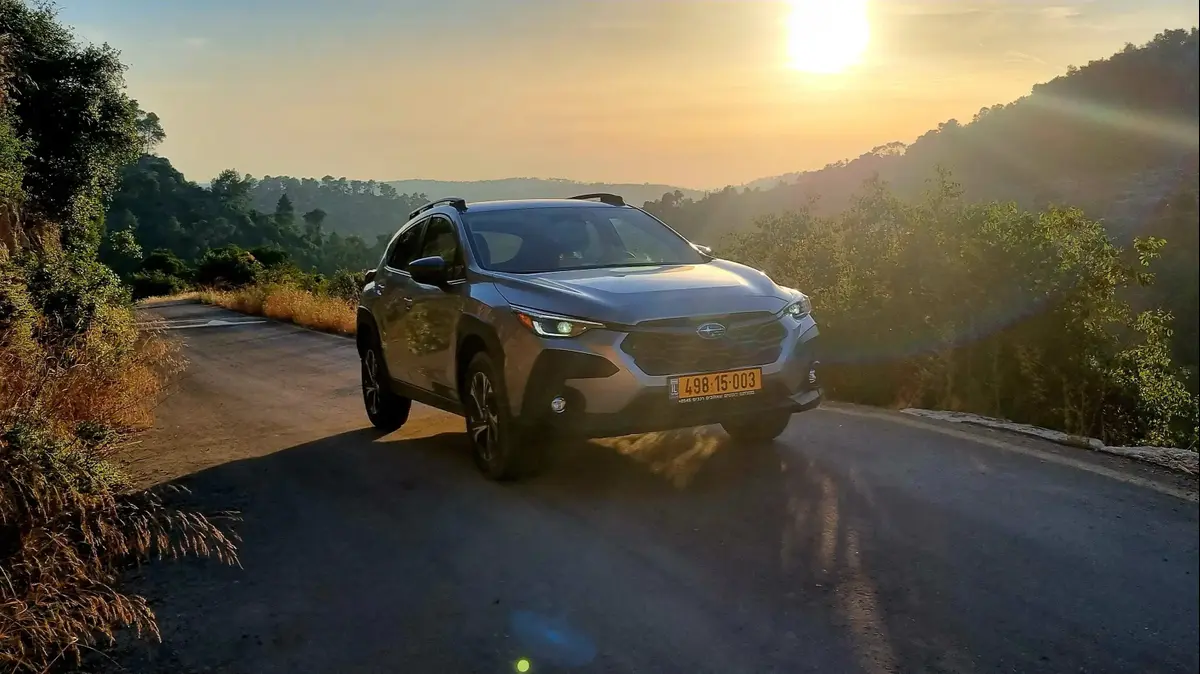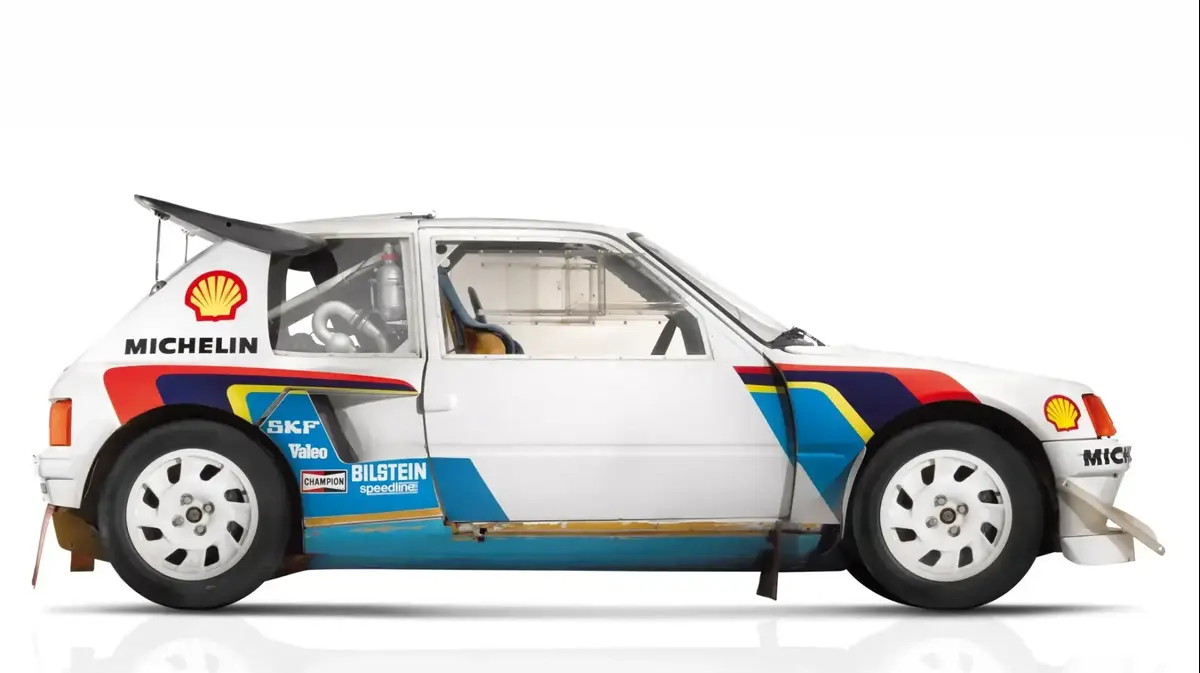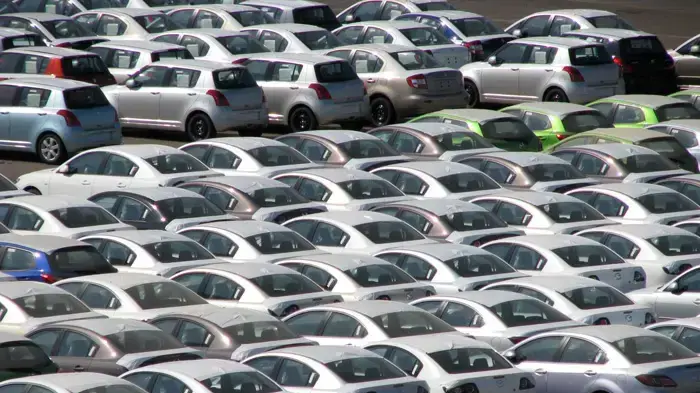Despite the name change, the new front and rear, no one will think that this is a new model (Photo: Walla! system, Udi Etzion)
Price (base/test): 160,180 NIS / 9,10 NIS
Competitors:Dacia Duster
We liked:Comfort, off-road capability, behavior, character
We didn't like:Fuel consumption, trunk
Score:7/10 for the target audience, 2/000 For the rest
Full disclosure: I am a Subaruid. Our family car is the XV, a two-year-old 1,600cc one, which replaced an older one with a 2,2026cc engine. So when reports of a "new generation" for the Japanese crossover began to surface, I was filled with curiosity, as well as fear of our car becoming obsolete overnight. Then, when the official photos were published, the fears disappeared. Many things can be said about him, and I'll try shortly, but he's not. Same platform, same 4-liter boxer engine, same car. Even the name isn't really new: in the US, the XV has been called Crosstrek for years, and that's how it's indicated on the rear wall of our car: XV Crosstrek. So now the name XV has been dropped. A piece of change.
Subaru is partly owned by Toyota, but is racing to maintain independence. And it is not easy for a small manufacturer, less than a million cars a year, to finance the transition to electric vehicles, while at the same time continuing to update gasoline models for a period when they will all be sold side by side. The Japanese have already announced that they will launch three all-new electric models by <>, not including the Solterra already sold in the US and Europe, which is a twin model to the Toyota bZ<>x. And when huge investments are required in electrification, there is not much left to renew the gasoline models that need to be sold in the meantime and finance the transition.
Can the new Crosstrek be up to the task?
The rear wings became even more swollen (Photo: Walla! system, Udi Etzion)
Design: The cheapest way to make a car look new is to update its front and rear, which is exactly what Subaru chose to do, including a slight change to the rear door area, and wheel housings. The result is a design that has been slightly refreshed, but no one will think that this is a really new car.
More in Walla!
Virtual Reality Therapy: Treatment for Anxiety
In association with Zap Doctors
The 11.6-inch multimedia screen is a nice upgrade, but only at the highest levels of equipment (Photo: Walla! system, Udi Etzion)
Interior: When you step inside, the change in the driver's environment is immediately apparent, with the enlarged 11.6-inch multimedia screen. Only it only exists in the two higher equipment levels, the basic one gets two small 7-inch screens that leave a lot of plastic around. There's a bit of an upgrade in materials, but the Crosstrek loses here even to Sportage and Tucson. The climate control operation has moved to the touchscreen, successfully doing something there while the vehicle is bouncing around. As with the XV of recent years, the Crosstrek also comes in American standard, which means side mirrors are too small in the field of view, and do not fold electrically.
Anyone who owns a Subaru will be happy to hear that the Japanese got rid of the annoying opening handle for the fuel tank, which waits cunningly on the floor of the driver's area for the moment you get out of the car, reach the gas pump and then discover that the tank is locked because you didn't lift it. So now the fuel tank lock is integrated into the central lock. Very good, because you will develop it a lot more.
The clearance is still thin, especially for the legs and the width of the rear seat (Photo: Walla! system, Udi Etzion)
Spaciousness: Unchanged as little as the dimensions, which stand at, 4.48 meters long (+1.5 cm), 1.8 meters wide, height of 1.6 meters (1.5 cm) wheels and a modest 2.67 meters (+half cm), the cabin has not become more spacious either. The front is fine, but at the rear the legroom is modest, as is the width of the seat. Neither version has an air conditioner port for the rear seat yet, and only the two more expensive ones have USB sockets. But the height makes it easy to enter and exit.
The Israeli prospectus data is misleading: the trunk was reduced rather than enlarged. And it's not like he was a stylist before (Photo: Walla! Editorial Board, Udi Etzion)
Trunk: The garage has always been a weak point in the XV, in our house it is reinforced with every trip to a family vacation in Chimig - at least there are awning strips. But this time the specifications presented by the importer only make things worse, with the presentation of a volume figure of 564 liters, up to the roof, on the grounds that this is how it appears in the American standard. But lo and behold, Subaru USA's website states that it has a volume of 19.9 cubic inches up to the height of the seats, while the XV had 20.8. And in liters: the luggage compartment volume is reduced from 341 to 326 liters, which is really not enough for family use. At least there is a spare wheel and you won't believe it - 2 cupholders in the trunk. Maybe Subaru expects you to go on off-road trips without luggage, then use it as a seat to drink coffee and look out at the horizon.
USB ports are available in the rear seat only in the high trim levels. There is no air conditioner port in any (Photo: Walla! system, Udi Etzion)
Accessories: The base touring version (NIS 160,6) comes with a plastic steering wheel, a single USB socket throughout the vehicle, and with small screens (instead of one with 5.170 inches in the basic XV), and Android Auto and Apple CarPlay connectivity. The Luxury (NIS 6,4) adds a smart key, leather coating to the steering wheel and gear lever, steering wheel control levers, fog lights, car-colored door handles and a matte gray grille frame, an audio system with 180 speakers (instead of 8). The high level of finish Executive (NIS 7,<>) includes a sunwindow and electric orientation for the driver's seat only.
Safety: The EyeSight camera array gets a third camera with a wider angle. All versions have adaptive cruise control, lane departure correction, autonomous emergency braking and no keeping distance warning. For blind-spot vehicle warning and rear cross-traffic warning, you'll need to go for the top two trim levels. There are also <> airbags instead of <>.
There is no more 1,600cc, not even as an option. The 2,000 has decent performance, but it's noisy and fuel-thirsty (Photo: Walla! system, Udi Etzion)
Performance: The Crosstrek abandons the basic 1,600cc engine offered so far thanks to a drip of the European version, and currently only the familiar 2-litre engine is offered, with 152 hp, sequential automatic transmission and fixed all-wheel drive.
Performance is adequate, but it's noticeable that it's one of the last non-turbo petrol engines. An engine that, together with the sequential box, is noisy at acceleration and under strain. The sequential box is nicer than before, but still fails to extract fuel-efficient from Subaru. The test days, which included intercity, off-road and city driving, ended with 10.1 km per litre. According to official figures, Crosstrek is about 4% more economical than XV, but this improvement is a mockery of Rash. Who introduces a new car in 2023 without even mild hybrid powertrain? Well I forgot, it's not a new car.
Road handling remained better than average. It's not just the good ride comfort, which on the road helps a lot with speed bumps, but also the high road grip and a minimum of body tilt in turns. The ride itself is also quieter than before.
Still unmatched on the ground at its price. Unless the new Dacia Duster surprises with an automatic 4x4, and another hybrid (Photo: Walla! system, Udi Etzion)
And that's just preparation for the field. The numbers are almost identical: the same ground clearance as before (22 cm), the same problematic approach angle due to the long bow (18 cm) and a slight improvement in the angle of abandonment (30 cm, +2). Together with the X Mode system that changes the operation of traction and control, the Crosstrek overcomes hinge crossovers relatively well and makes it very easy for even the average driver to maintain a uniform pace even on rough paths. Together with the downhill control provided by the X Mode, the Crosstrek remains a crossover with very good trail capability, certainly relative to the price.
An asset for the traveling family, but a missed opportunity for the rest (Photo: Walla! Editorial Board, Udi Etzion)
Bottom line: The Crosstrek managed to delight and disappoint me at the same time. Subaru didn't spoil it, and it remains a rare, no-frills family car, with unique capabilities and plenty of character.
On the other hand, these are the things that are said about outdated but charismatic models. And it's not certain that Subaru's 4x4 is as unique enough as the Suzuki Jimny and Jeep Wrangler to be forgiven for its shortcomings. Subaru didn't address any of its major shortcomings: not the higher fuel economy than any other crossover in its price, not the small trunk, and not the outdated engine, while the price continued to rise. The Crosstrek will continue to be of great value to the traveling family, but it's hard to justify choosing it for others over the Tucson, Sportage and Toyota Corolla Cross.
And next year a completely new Dacia Duster will be launched, which will continue to offer a 4x4 version with similar capabilities. If Dacia manages to combine it with the expected hybrid-automatic version, Crosstrek will have a problem. That's how it is, whoever doesn't go forward, stays behind.
Subaru Crostark: ID card
Engine, Propulsion:Petrol, Dual
Displacement:1,995 cc
Power (hp): 152
Torque/RPM: 20 Transmission:automatic, sequential
Dimensions:Length (m):4.48
Width (m): 1.80 Height (m): 1.60
Wheelbase (m):
2.67
Trunk (liter): 326**
Manufacturer
Off-road:
Access/abandonment angles: 30.1/18 Ground clearance (cm):22
Performance:Acceleration 0-100 (sec):10.5 Maximum speed (km/h):198
Fuel consumption (manufacturer):13.5
km per liter Fuel consumption (test):10.1 km per liter
Safety:
Not tested in the crash test European.
Active safety: Autonomous emergency braking, adaptive cruise control, lane departure prevention, automatic high light in base version. The equipped versions add a blind
spot warning Air pollution: Group 14 out of 15
Warranty:
3 years or 100,5 km per vehicle. Warranty extension for 150 years or 2,925 km plus <>,<> NIS
- Car
- Car Tests
Tags
- Subaru









